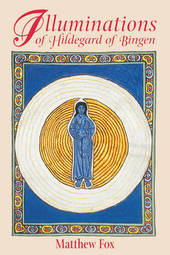
|
Illuminations of Hildegard of Bingen
Paperback / softback
Main Details
| Title |
Illuminations of Hildegard of Bingen
|
| Authors and Contributors |
By (author) Matthew Fox
|
| Physical Properties |
| Format:Paperback / softback | | Pages:216 | | Dimensions(mm): Height 229,Width 152 |
|
| Category/Genre | Mind, Body, Spirit - thought and practice |
|---|
| ISBN/Barcode |
9781879181977
|
| Classifications | Dewey:248 |
|---|
| Audience | | General | | Tertiary Education (US: College) | |
|---|
|
Publishing Details |
| Publisher |
Inner Traditions Bear and Company
|
| Imprint |
Bear & Company
|
| Publication Date |
31 January 2003 |
| Publication Country |
United States
|
Description
Hildegard of Bingen (1098-1179) was an extraordinary woman living in the Rhineland valley during most of the twelfth century. Besides being the abbess of a large and influential Benedictine abbey, she was a prominent preacher, healer, scientist and artist. She was also a composer and theologian, writing nine books on theology, medicine, science and physiology as well as 70 poems and an opera. At the age of 42 she began to have visions; these were captured as 36 illuminations - 24 of which are recorded in this book along with her commentaries on them.
Author Biography
Matthew Fox is a well-known lecturer and scholar and is president and founder of the University of Creation Spirituality in Oakland, California. He is the author of 24 books, including Original Blessing, Meditations with Meister Eckhart, The Coming of the Cosmic Christ, and One River, Many Wells. He lives in Oakland, California.
Reviews"If one person deserves credit for the great Hildegard renaissance in our time, it is Matthew Fox. Here in the long-lost legacy of Hildegard of Bingen is a mystical genius who could help to illumine the human soul spiritually, ecologically, politically--in every dimension of life." * Mary Ford-Grabowsky, author of Sacred Voices * "She [Hildegard] castigated a pope for his timidity and an emperor for moral blindness. She taught scholars and preached to clergy and laity as no woman before her had ever done. . . . She claimed that now woman rather than man--obviously Hildegard herself--was to do God's work. It is difficult not to see in her visionary experience and activism, as well as her claim for the mission of woman in a male-dominated age, a gesture of protest, the reaction of an intelligent and energetic woman who chafed under the restraints imposed on women by the culture in which she lived." * Bernard W. Scholz, The American Benedictine Review * "We find relatively few Christian guides in the past to enlighten or to inspire us to a more functional relationship between the human and the natural worlds. . . . Hildegard might be considered a model with her sense of the earth as region of delight. . . . She has reached far into the emotionally exciting aspects of nature in a unique mode of Christian communion. She sees the creation maker in the ancient manner of the fertility cults, a view she expresses in her statement that creation and creator are related as woman and man. Only thus is the earth fruitful. . . . Because of this 'erotic' bond the earth becomes luxuriant in its every aspect." * Thomas Berry, author of The Great Work and The Dream of the Earth *
|